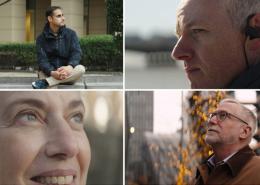Finding Breakthroughs in Sickle Cell Disease: Patients and Advocates Lead the Way

In most types of clinical research, a large number of patients participate in studies that explore an experimental treatment or approach. This decades-old process is how some of the most impactful, and even lifesaving therapies have come to be, from cancer drugs to COVID-19 vaccines.1
But what happens when scientists need to study a rare disease, one that doesn’t affect a high percentage of people? And what if those who are affected don’t participate because of social disparities, underrepresentation, or general mistrust in the medical system?
These are some of the biggest challenges with sickle cell disease (SCD), a painful, rare genetic blood disorder often diagnosed in infancy, and particularly sickle cell anemia, one of four common types of SCD that is often considered the most severe. The condition affects about 100,000 Americans, predominantly people of color.2,3 Though outcomes have improved over the years, improving treatment for sickle cell disease still hits roadblocks due to some of the unique healthcare challenges that minority communities have encountered and continue to face.
But patients and patient advocates are working hard to break through such barriers. With their help, the medical research community is able to work toward more effective treatments for this hard-to-cure disease.
Why Sickle Cell Disease Clinical Trials Are Challenging
Sickle cell disease comes with many unique challenges for patients interested in participating in clinical research. For one, accommodating the frequency of required research site visits can be difficult for some people — all the more challenging amid COVID-19 and the underlying disparities it has exacerbated among communities of color.4
“Generally, a clinical study can be a big commitment in terms of time and travel,” says Steven Arkin, Head of Rare Hematology Clinical Research at Pfizer. “And when you consider that sickle cell disease is often diagnosed when a patient is very young, it's understandable that families may have less ability to manage those burdens.”
Underrepresentation factors in, too. While many SCD patients are of African ancestry, many physicians are not.5 This can make it more difficult to recruit or engage potential study participants.
Some people of color also deeply mistrust the medical community after past wrongs such as the Tuskegee syphilis experiments.6 Still, mistrust doesn’t just come from historical tragedy. Modern-day biases, even when unconscious, can perpetuate mistrust, including when some healthcare professionals dismiss or downplay SCD patients’ descriptions of their pain.7
Quintissa Peake, who was diagnosed with sickle cell disease at 11 months old, has experienced these biases first-hand. Growing up with frequent episodes of sickle cell crisis, including uncontrolled swelling in her hands and feet as well as lingering pain in her arms and legs, Peake has been no stranger to symptoms of this disease. Unfortunately, not all of her providers have been as familiar with the condition.
“So many of us sickle cell patients are stigmatized when we are experiencing the pain of a sickling crisis,” says Peake, now 40. “We go to the emergency room because that’s what you’re supposed to do when you need medical help. But once there, we may be treated as if we are just seeking drugs.”
These experiences have soured many patients’ interactions with the medical community, which sets back clinical research as trial spots go unfilled.
That’s where advocacy comes in — to educate, engender trust and expand interest in clinical research.
Patients Fighting for Their Voice
Among other things, patient advocacy involves a two-way communication between the medical institution — such as drug companies, researchers and healthcare professionals — and patients.8 Advocates, like Beverly Francis-Gibson, help facilitate these conversations via town halls, social media, email, and other channels so that both groups can share their perspectives and ask questions.
“I aim to help patients have an understanding and education of clinical trials if they’re interested in participating, and I also work with the pharmaceutical industry to ensure they hear directly from patients before starting their trial,” says Francis-Gibson, formerly the President and Chief Executive Officer of the Sickle Cell Disease Association of America (SCDAA). Francis-Gibson also has loved ones with SCD, which helps her connect with patients. “It’s important that I be that trusted person who reaches out to the patient community so that they can feel like I have their best interest at heart.”
Pharma representatives such as Mariah Kelly of Pfizer’s patient advocacy team are on the other side of that dialogue. Sharing details about new trial opportunities while fielding questions from patients, Kelly makes it her mission to partner and connect with the advocate community.
“We work closely with the sickle cell community in the drug discovery and development process to find solutions together. These collaborative engagements with patients, caregivers and advocates are essential to help address the needs of patients,” says Kelly, Patient Advocacy Director at Pfizer. “Together we focus on a range of factors to build and support a meaningful program that meet the needs of the patients. Most importantly, we listen and learn. Only advocates and patients can help us understand the reality of what they’re going through and how they’re feeling. This is essential for any kind of meaningful steps forward to help address sickle cell disease.”
As patient and patient-advocate, Peake finds herself in both worlds. After receiving multiple blood transfusions in college, she got to know the community and began volunteering with her local blood bank. In time, she’s found her voice as a self-proclaimed “sickle cell survivor.”
“I’ve realized that I need to be an advocate for myself and others," she says, "and with technology now, there are so many opportunities to share my story on social media and locally." Peake, who is also involved in the SCDAA, explains, “When I grew up, I was the only person in my family with this disease. It felt isolating. Advocacy helps us build a community of warriors so that we feel less alone.”
Not only has that emotional support given Peake and others strength through hard times, but it has also led to new scientific frontiers in sickle cell treatments. Without advocates working to break through the barriers and expand the reach of clinical trials, many therapies might never have existed at all.
“As I’ve gotten older, the treatment options for sickle cell have definitely expanded drastically,” Peake says. “When I was a baby, doctors told my parents I wouldn’t make it out of adolescence. But look at me now. Look at all of us.”
![]()





